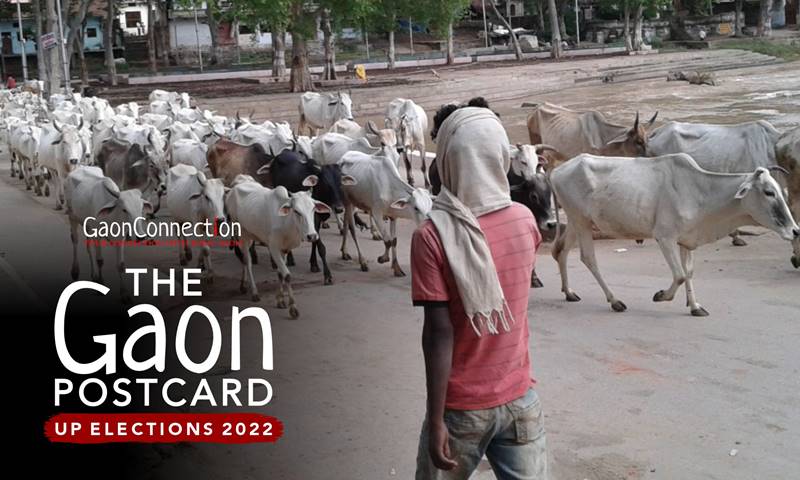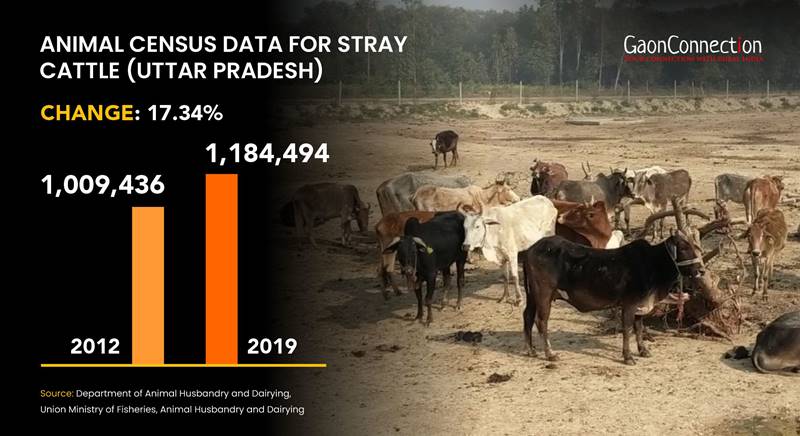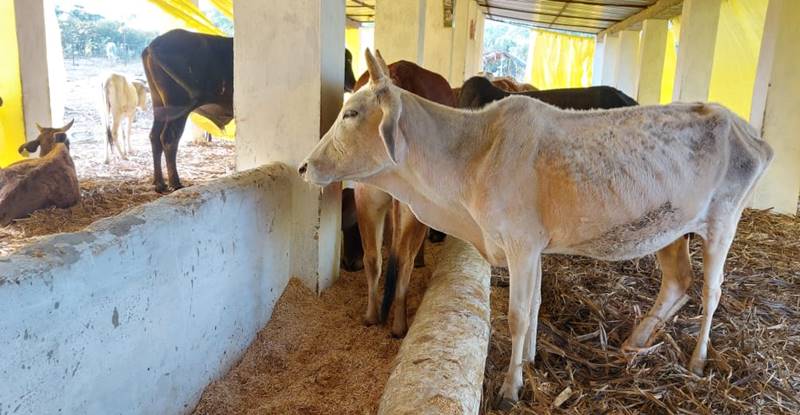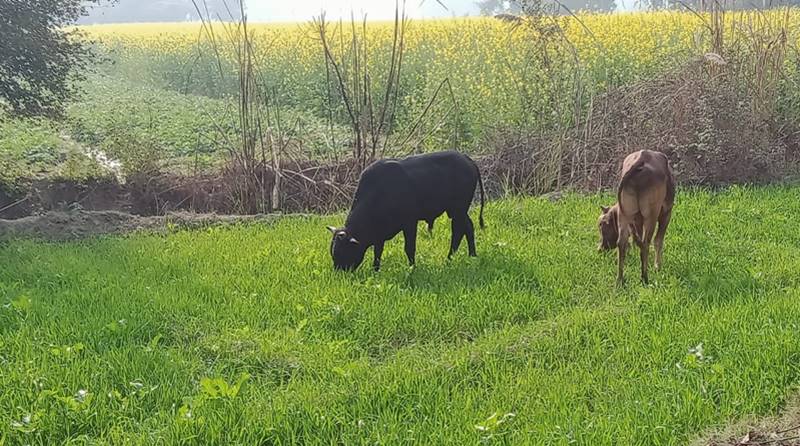Holy cow? Not for the UP farmer, who now spends nights protecting crops against stray cattle attacks
Stray cattle in the rest of the country have reduced by 3.2% from 2012 to 2019. However, their population has registered a 17.34% increase in Uttar Pradesh. Though the state government has set up cattle shelters, levied additional taxes, and launched cow welfare schemes, farmers continue to suffer crop losses. A ground report as part of Gaon Connection’s ‘The Gaon Postcard’ series.

On the biting cold winter morning of January 4, the government primary school in Akhaura village received some unexpected guests — stray cattle. Desperate and sleep-deprived farmers of this village in Sitapur district of Uttar Pradesh had rounded up the cows and bulls and brought them to the school (shut due to the pandemic), as a last resort to protest against the growing problem of chhutta pashu (stray cattle).
“Majboori hai, saheb (We are compelled to do this). We spend chaubees ghante (24 hours) away from our kids and families to guard our fields,” Sunil Sharma, a resident of Akhaura village, who along with a bunch of other farmers had herded the stray cattle into the school premises, told Gaon Connection.
Also Read: UP’s villages might vote again on caste and religion. But what they desperately want: clean water.
“We spend the biting cold days and nights out in the open in our fields. Even then, these chhutta pashu destroy our crops,” said the exasperated farmer. Sunil had cultivated wheat on five bighas (almost a hectare) of land. He had reaped the harvest of only 2.5 bigha of land last year, the remaining crop was destroyed by the stray cattle. “I have four kids. What will I feed them? Farming is our only means of survival,” he said.

Also Read: Cows were a source of income. When did they become a headache for farmers?
Farmers have decided to raise the issue of chhutta pashu in the upcoming assembly elections in the state, Shyamu Shukla, a member of Bhartiya Kisan Union Awadh, a state-level farmers’s organisation, told Gaon Connection.
“All efforts by the government to solve the crisis of stray cattle have fallen flat. Rural Uttar Pradesh is fed up with chhutta pashu,” Shukla said. “Taxes were imposed to set up shelters for the animals but all the money has just got wasted due to corruption and the farmers continue to suffer,” he alleged.
However, a state-level functionary of the ruling BJP government dismissed stray cattle becoming an electoral issue.
“I don’t think stray cattle will be a poll issue. No government has ever worked on this issue before. The BJP government has set up cow shelters on an unprecedented scale. I don’t think villagers or farmers are suffering due to stray cattle menace,” BJP spokesperson Manish Shukla told Gaon Connection.
Rise in stray cattle population
In India’s most populous state Uttar Pradesh, which is going to polls between February 10 and March 7, hundreds of thousands of farmers are struggling as their crops are routinely destroyed by the stray cattle. This has pushed them deeper into the abyss of crop losses, and the growing incidence of extreme weather events has not helped matters.
A quick look at the data compiled under the 20th Livestock Census-2019 All India Report reveals the growing problem of stray cattle in Uttar Pradesh.
Whereas the total number of stray cattle in the country has reduced by 3.2 per cent from 2012 to 2019, their population has registered a whopping 17.34 per cent increase in Uttar Pradesh in the same time period. According to the livestock census data for 2019, there were more than 1.18 million stray cattle in the state.

Rajan Singh, a 45-year-old farmer from Samogra village in Mirzapur district, told Gaon Connection that stray cattle had destroyed his harvest for two consecutive seasons.
“What is left behind of my harvest can only be used as animal feed,” Rajan complained. “I invest as much as seven to eight thousand rupees in a crop cycle and I recover next to nothing. I just sell whatever is left behind as cattle feed. The price I get for it doesn’t even meet the input cost,” he added.
“Farmers are tired. The utter failure of the BJP government in dealing with stray cattle menace is obvious. The gaushala and sanrakshan kendras are in a deplorable condition,” Anand Bhadouria, member of legislative council (MLC) and spokesperson of the Samajwadi Party, told Gaon Connection.
On the same day (January 4), when farmers locked up stray cattle inside the school premises in Sitapur, nearly 500 cultivators gathered, about a kilometer away, at the Bhakauhra bridge on river Gomti to raise their grievances at a public meeting organised by a farmers’ organisation.
Also Read: While you were sleeping under your blanket, the farmers were busy doing this
“This protest by farmers will not be limited to Sitapur alone. If the administration fails to come up with a mechanism to handle the stray cattle menace, this issue will become a bada mudda [a big poll issue] for the upcoming assembly elections,” warned Shukla of Bhartiya Kisan Union Awadh.
Schemes to tackle stray cattle
To address the growing problem of stray cattle, the state government has launched a series of schemes and projects. These include setting up of cattle shelters (gaushala), adoption of stray cows, levying taxes, giving stray cows to malnourished families, cow protection centres, and more.
As per the official data provided by Uttar Pradesh’s Animal Husbandry Department, there are 545 registered cattle shelters (gaushala) in the state.

Apart from these cattle shelters, as on January 7 this year, there are 5,515 ‘Gau Sanrakshan Kendras’ (Cow Protection Centres) in the state to accommodate stray cattle, Arvind Kumar Singh, additional director (Godhan), Animal Husbandry Department, informed Gaon Connection.
A gaushala is distinct from a cow protection centre as the former is a permanent building much larger than the gau sanrakshan kendra, which is a temporary cattle shed on a patch of wasteland.
Official data also declared that over 103,000 stray cows have been adopted by 56,853 people in the state.
Also Read: Should cows be declared the national animal of India?
In November 2021, the state government declared that it was looking at rehabilitating about 400,000 stray cattle over the following two months. The animal husbandry department is also considering deploying vans or “cattle catchers” at the block level in rural areas, to bring the animals to the shelters.
Over-crowded cattle shelters
Gaon Connection visited some of the cow shelters in Sitapur, Shahjahanpur and Mirzapur to assess the ground situation.
On December 13, Gaon Connection visited a gaushala at Shahjahanpur’s Tilhar area and found that the cattle that were housed inside it far exceeded its capacity. The Tilhar sub-divisional magistrate (SDM) said that the efforts were underway to set up another shelter.
“The number of cattle in some of the gaushala in Tilhar is around one hundred and seventy five while the capacity is sixty to seventy animals. We are identifying areas to set up another shelter as the present one is overcrowded,” SDM Himanshu Upadhyay told Gaon Connection.
The story was something similar at another cattle shelter in Sitapur district. On December 21, when Gaon Connection found the number of cattle far exceeded the stated capacity at the Chandra gaushala in Chandra village of Pisawan block.
“We have repeatedly asked for funds for the maintenance of the gaushala but haven’t received anything so far. I have requested the district administration to take over the gaushala’s management as the gram panchayat is not in a condition to afford its functioning,” Harivansh Trivedi, the village head of Chandra, told Gaon Connection.
“There are about 160 cattle here while the capacity is not more than 100,” the village head added.

The chief veterinary officer of Sitapur told Gaon Connection that 11,634 stray cattle in the district have been rescued so far. There are 77 cattle shelters in the district. “Seventeen crore rupees have been sent to the 65 tehsils (towns) for maintenance of these shelters for the ongoing financial year (2021-22),” said Prabhat Kumar Singh.
Also Read: Costly fodder adds to the woes of cattle farmers as they were already struggling to sell milk
The chief veterinary officer of Sitapur also said that 2,441 cows were allotted to the beneficiaries in the district as part of the government scheme that will benefit malnourished families (by providing them cows for milk).
Rakesh Rathore, member of legislative assembly (MLA) from Sitapur, said that financial irregularities and delays in payments to these shelters had resulted in the failure of the government schemes to address the stray cattle menace.
“The gaushalas have been constructed but the basic amenities for the animals are missing. The animals are dying of hunger and disease in these shelters. There isn’t enough fodder or medicines for these cattle,” MLA Rathore said.
However, Prabhat Kumar Singh, the chief veterinary officer of Sitapur, clarified: “If the money is not being transferred further at the sub-division level and block level, respective authorities are answerable for it.”
Also Read: At cow shelters near Lucknow, animals stood naked, shrunk due to cold
Regulating cattle trade
The debate around cattle trade gained momentum following the Union government’s notification dated May 23, 2017 that criminalised the sale of cattle for non-agricultural purposes. In the aftermath of the controversial legislation, incidents of ‘gauraksha’ or cow vigilantism rose and fringe mobs began to attack people found to be transporting cattle.
Following opposition to the notification from states like Kerala and West Bengal, the Union government withdrew the notification within six months on November 30, 2017.
But the state government approved a draft ordinance on June 11, 2020 to amend the Uttar Pradesh Prevention of Cow Slaughter Act, 1955, which strengthened the already existing law and increased the quantum of punishment for the accused.

According to Fareed Mehfooz Kidwai, former minister of state for planning and Samajwadi Party leader, there has been an ‘exponential increase’ in the cases of farmers suffering losses due to stray cattle because of rising cow vigilantism in Uttar Pradesh.
“The government has failed to nab the criminals who were responsible for lynching people who allegedly were transporting beef. It created an atmosphere of fear. No farmer wished to keep cattle as they could no longer be sold. As a result, an unprecedented number of animals were abandoned,” Kidwai told Gaon Connection.

The leader went on to add that the laws to criminalise slaughter of cattle were indeed very important as cows are a respected animal in Indian society. “The problem of stray cattle needs an effective solution. But, the plans to create cow shelters are only on paper. An effective implementation, keeping in mind the losses suffered by the farmers, is needed,” Kidwai said.
Similar concerns were voiced by Shukla of Bhartiya Kisan Union Awadh who said that after the Union government’s notification on cattle trade, major cattle traders and slaughter houses across the state began to release their cattle in the open.
“The slaughterhouses got rid of the cattle to escape legal action as well due to the pressure by fringe groups. The number of cattle on the roads and the fields rose significantly,” the farmer leader said.
Also Read: Can India safeguard its 50 native breeds of cows?
Taxes imposed to tackle stray cattle
In order to raise revenue for the welfare of cows and stray cattle at large, the state government had announced additional taxes in January, 2019. Half a per cent tax is levied on excise items like alcohol, while one per cent was taxed on mandi parishads (marketing committees).
Briefing media persons in Lucknow on January 19, 2019, state government spokesperson and power minister Srikant Sharma had stated that the government will collect an additional revenue of Rs 165 crore annually by imposing a special fee on excise.
“While an additional fee of Re 0.50 to Rs 2 will be imposed per bottle of beer and IMFL (Indian-made foreign liquor), the special fee would be Rs 10 per bottle consumed in the bars to fund the stray cow shelters in the state,” the minister Sharma was quoted as saying.

“The amount raised by these taxes has not reached its designated beneficiaries,” pointed out Kidwai, the member of the Samajwadi Party. “Not even one per cent of this amount has gone into animal welfare, nobody knows where it went. If this money was spent honestly, then Uttar Pradesh wouldn’t have been facing this crisis today,” he said.
Also Read: Cows are not a problem, but a solution. All we need to do is shift our focus
However, Arvind Kumar Singh, the Additional Director (Godhan) in the Animal Husbandry Department denied these allegations.
“All the 5,515 cow conservation centres are being run efficiently. A total of 809,927 stray cattle (both cows and bulls) have been rescued by these centres so far. These centres have both green and dry fodder for ensuring the good health of these animals. All is well and good,” Singh told Gaon Connection.
However, he stated that his department does not have the record on the revenue raised by the cess for cow welfare in the state. Nor did he reveal the amount spent on stray cattle conservation.
Cow welfare scheme
As per the state government’s press release, under the cow conservation programme, so far, 103,785 people have adopted cows.
On August 6, 2019, the state government launched ‘Mukhyamantri Nirashrit Besahara Govansh Sahbhagita Yojana’. It is a welfare scheme that invites people, especially in the rural areas, to take up rearing cows and pays them Rs 30 per day (Rs 900 per month), if they do so.
Kannauj district’s chief veterinary officer told Gaon Connection that this welfare scheme was being successfully implemented.
“There are 38 gauvansh aashray (cow shelters and conservation centres) in the district. Out of these, four are registered gaushalas (cow shelters) and house 352 cattle,” Sanjay Shalya told Gaon Connection. “An unemployed person can avail upto six animals and receive nine hundred rupees per animal per month. A total of 5,086 animals have been sheltered so far in these animal shelters,” he added.

“Arre kaun si scheme bhai… [which scheme is this?]” Shiv Ram, a 65-year-old farmer from Unnao’s Durjan Khera village asked Gaon Connection in exasperation, as he sat out in his field on the night of January 2.
“Not a single grain is safe from stray cattle. We spend all night in the cold to look after our fields,” Shiv Ram lashed out. “They say that the country is developing, I am telling you only cows and bulls are progressing here,” the old farmer added.
Farmers in Mirzapur district pointed out another problem. “The administration should ensure that the cattle do not leave the shelters. It is often seen that the cows that are adopted by the people return to our fields and spoil the crops,” Shiv Yadav, a 55-year-old farmer from Islampur village in Mirzapur’s Lalganj town, complained to Gaon Connection.
‘Strict action against abandoning cows’
In Shahjahanpur, Deepak Gupta, district head of Rashtriya Gaurakshak Dal — an organisation that volunteers for cow-protection – demanded strict action against animal rearers who abandon their cattle.
“People have begun to perceive cows and bulls as a burden. It’s not as if agriculture and cattle haven’t coexisted in this country. But people are devoid of sentiments now,” said Deepak Gupta.
“The cattle should be tagged in order to identify the rearers who abandon them. We demand strict action against such rearers,” he added.
Also Read: “If the farmers take meaningful initiatives, income can be generated from cow dung”
However, cattle traders have a different point of view. “The government action on cattle trade is the original problem. Why do you think this issue hasn’t been so serious before? We can’t even think of procuring cattle from Uttar Pradesh, we buy it from states like Bihar,” Bante Kumar, a Unnao-based cattle trader, told Gaon Connection.
“It’s not just about our loss, farmers are fed up too,” the cattle trader said.
Written by Pratyaksh Srivastava
With inputs from Mohit Shukla (Sitapur), Ramji Mishra (Shahjahanpur), Brijendra Dubey (Mirzapur), Sumit Yadav (Unnao), Virendra Singh (Barabanki), Arvind Singh Parmar (Lalitpur), and Ajay Mishra (Kannauj).

